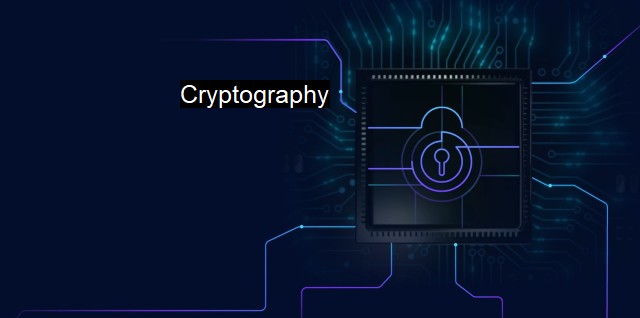What is Cryptography?
Cryptography: Ensuring Privacy and Security in the Digital Age through Mathematical Algorithms and Key Secrecy
Cryptography refers to the process of encoding information that only authenticated parties can understand and use. it plays a vital role because it helps protect data from interception and unauthorized usage. cryptography allows for secure communication in the presence of malicious adversaries.The etymology of 'cryptography' holds insightful explanations about its functionality. The term originates from the Greeks, where "cryptos" means hidden or secret, and "graphein" means to write. So, cryptography is hidden writing or writing in secret code. This makes it an integral part of information security where protecting data privacy and user identities is paramount.
Cryptography can be traced back to the times of Julius Caesar, who used a simple encryption technique known as the Caesar Cipher to secure military communications. Today's methods are more sophisticated, providing robust security elements that establish a secure cyber environment in this highly interconnected world.
The chief objective of cryptography is scrambling plain information into code to evade snoopers. It ensures that digital transactions, emails, files, bank accounts, and the transfer of sensitive information in digital form occur securely. The fundamental goal is to shield critical transactions and secure confidential information from theft, manipulation, or interception by cybercriminals.
Modern cryptography has four primary tactics: Confidentiality, integrity, non-repudiation and authentication. Confidentiality ensures that only intended recipients can access and decipher information. Integrity guarantees that an information transfer remains unchanged, maintaining the data as per the original intention. Non-repudiation ensures that a party involved in communication cannot deny involvement. And Authentication is utilized to validate the sender and receiver's identities, ensuring that intrusion is kept at bay.
Companies employ Cryptography to safeguard financial transactions, customer data, and other sensitive business information. As sensitive data moves inflow, data is encrypted to render it unreadable if thieves capture it in transit. The receiver party holds a key to decrypt the information and return it to a readable format. If the cybercriminals intercept the data but don't have this decryption key, the data will remain secure and inaccessible.
Cryptography is also used extensively in Antivirus Software and other defensive threat mitigation applications. Antiviruses attempt to identify and neutralize threats before they materialize, using complex cryptographic algorithms to detect strange program behaviour suggestive of a possible virus or a malware. cryptography powers antivirus suites to spot where threat signatures reside while maintaining the integrity of encrypted files.
Public key encryption, hash functions, and digital signatures are fundamental features encountered in cryptography. In public key encryption, two keys are involved - a public key for encryption and a private key for decryption. This allows for data to be shared securely even over insecure networks.
Hash functions are another key feature of cryptography where any input yields the same fixed-size string of bytes, which can be used as a checksum to verify data integrity. Digital signatures offer a means to verify the authenticity of information and the identity of party involved. Both hash functions and digital signatures are instrumental in accomplishing the goals of confidentiality, integrity, and non-repudiation efficiently.
It's vital to bolster applied cryptography continually because cyber threats are constantly evolving. Cryptanalysis, the study of cryptographic systems with the aim to find vulnerabilities in them, is a means to stay ahead of these emerging vulnerabilities.
As we become more reliant on digital networks for business and personal uses, cryptography will increasingly become more integral. Protection against unauthorized data access is of utmost importance, making it a top-tracked topic in computer science and cybersecurity. Cryptography empowers us to communicate safely over the vast and potentially threatening digital landscape. Thus, mastering cryptography should be a primary focus for information security professionals as technology continues its ever-accelerating pace of development.

Cryptography FAQs
What is cryptography?
Cryptography is the practice of securing communication from unauthorized access or disclosure. It involves the use of mathematical algorithms to convert plain text into a cipher text that can only be understood by those who have the key to decrypt it.How is cryptography used in cybersecurity?
Cryptography is a crucial aspect of cybersecurity as it ensures that sensitive information such as passwords, credit card details, and other personal data are protected from unauthorized access. It is used to secure communication channels, authenticate users, and safeguard electronic transactions.How does cryptography help in antivirus?
Cryptography plays a critical role in antivirus software by enabling the encryption of malware signatures, making it difficult for cybercriminals to reverse engineer them. This helps in detecting and removing known malware from a system. It also helps in securing the communication between antivirus software and the server by encrypting the data sent and received.Is cryptography foolproof?
No, cryptography is not completely foolproof. Cryptographers can develop highly complex algorithms to make it difficult for hackers to decipher them, but there is always the possibility of attackers finding weaknesses in the encryption keys or algorithms used. Thus, it is essential to constantly update and improve cryptographic protocols to stay one step ahead of potential attackers.Related Topics
Encryption Digital signatures Public key cryptography Hash functions Authentication protocols
| | A | | | B | | | C | | | D | | | E | | | F | | | G | | | H | | | I | | | J | | | K | | | L | | | M | |
| | N | | | O | | | P | | | Q | | | R | | | S | | | T | | | U | | | V | | | W | | | X | | | Y | | | Z | |
| | 1 | | | 2 | | | 3 | | | 4 | | | 7 | | | 8 | | |||||||